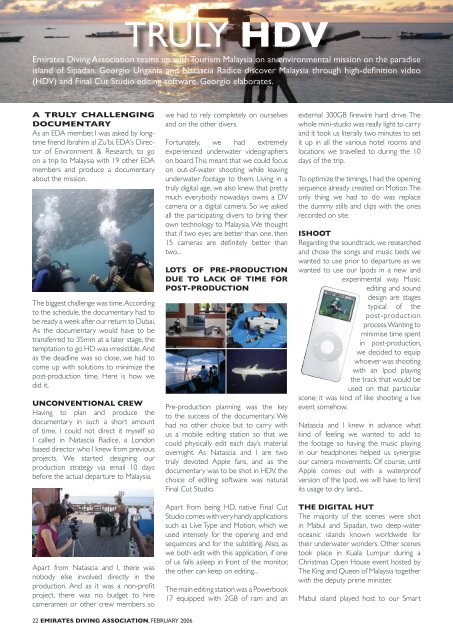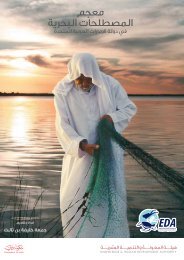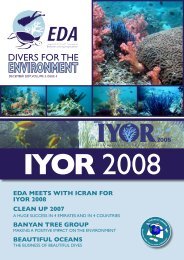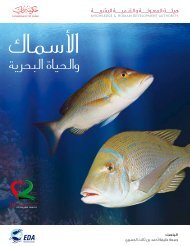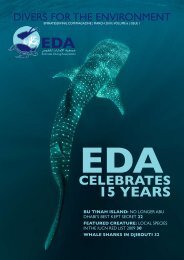EDA February 2006.indd - Emirates Diving Association
EDA February 2006.indd - Emirates Diving Association
EDA February 2006.indd - Emirates Diving Association
- No tags were found...
Create successful ePaper yourself
Turn your PDF publications into a flip-book with our unique Google optimized e-Paper software.
TRULY HDV<strong>Emirates</strong> <strong>Diving</strong> <strong>Association</strong> teams up with Tourism Malaysia on an environmental mission on the paradiseisland of Sipadan. Georgio Ungania and Natascia Radice discover Malaysia through high-definition video(HDV) and Final Cut Studio editing software. Georgio elaborates.A TRULY CHALLENGINGDOCUMENTARYAs an <strong>EDA</strong> member, I was asked by longtimefriend Ibrahim al Zu’bi, <strong>EDA</strong>’s Directorof Environment & Research, to goon a trip to Malaysia with 19 other <strong>EDA</strong>members and produce a documentaryabout the mission.The biggest challenge was time. Accordingto the schedule, the documentary had tobe ready a week after our return to Dubai.As the documentary would have to betransferred to 35mm at a later stage, thetemptation to go HD was irresistible. Andas the deadline was so close, we had tocome up with solutions to minimize thepost-production time. Here is how wedid it.UNCONVENTIONAL CREWHaving to plan and produce thedocumentary in such a short amountof time, I could not direct it myself soI called in Natascia Radice, a Londonbased director who I knew from previousprojects. We started designing ourproduction strategy via email 10 daysbefore the actual departure to Malaysia.Apart from Natascia and I, there wasnobody else involved directly in theproduction. And as it was a non-profitproject, there was no budget to hirecameramen or other crew members sowe had to rely completely on ourselvesand on the other divers.Fortunately, we had extremelyexperienced underwater videographerson board. This meant that we could focuson out-of-water shooting while leavingunderwater footage to them. Living in atruly digital age, we also knew that prettymuch everybody nowadays owns a DVcamera or a digital camera. So we askedall the participating divers to bring theirown technology to Malaysia. We thoughtthat if two eyes are better than one, then15 cameras are definitely better thantwo...LOTS OF PRE-PRODUCTIONDUE TO LACK OF TIME FORPOST-PRODUCTIONPre-production planning was the keyto the success of the documentary. Wehad no other choice but to carry withus a mobile editing station so that wecould physically edit each day’s materialovernight. As Natascia and I are twotruly devoted Apple fans, and as thedocumentary was to be shot in HDV, thechoice of editing software was natural:Final Cut Studio.Apart from being HD, native Final CutStudio comes with very handy applicationssuch as Live Type and Motion, which weused intensely for the opening and endsequences and for the subtitling. Also, aswe both edit with this application, if oneof us falls asleep in front of the monitor,the other can keep on editing...The main editing station was a Powerbook17 equipped with 2GB of ram and anexternal 300GB firewire hard drive. Thewhole mini-studio was really light to carryand it took us literally two minutes to setit up in all the various hotel rooms andlocations we travelled to during the 10days of the trip.To optimize the timings, I had the openingsequence already created on Motion. Theonly thing we had to do was replacethe dummy stills and clips with the onesrecorded on site.ISHOOTRegarding the soundtrack, we researchedand chose the songs and music beds wewanted to use prior to departure as wewanted to use our Ipods in a new andexperimental way. Musicediting and sounddesign are stagestypical of thepost-productionprocess. Wanting tominimise time spentin post-production,we decided to equipwhoever was shootingwith an Ipod playingthe track that would beused on that particularscene; it was kind of like shooting a liveevent somehow.Natascia and I knew in advance whatkind of feeling we wanted to add tothe footage so having the music playingin our headphones helped us synergiseour camera movements. Of course, untilApple comes out with a waterproofversion of the Ipod, we will have to limitits usage to dry land...THE DIGITAL HUTThe majority of the scenes were shotin Mabul and Sipadan, two deep-wateroceanic islands known worldwide fortheir underwater wonders. Other scenestook place in Kuala Lumpur during aChristmas Open House event hosted byThe King and Queen of Malaysia togetherwith the deputy prime minister.Mabul island played host to our SmartResort headquarters. Here, we stayedin very comfortable, basic wooden hutsthat were well-equipped with electricalsockets. To Natascia and I, that was evenmore important than having hot runningwater...One hut was reserved for the mobileediting station and was immediatelylabelled “the digital hut“. Here, we hadall the computers and an incredibleamount of chargers for all the batteriesand adaptors and so on. At the end ofeach day, we digitized all the tapes tohard disk and transferred the hundredsof digital photographs to the Ibook forphoto retouching.To gain time, we decided not to log andcapture each tape but to download thewhole content and do the logging at alater stage. The Sony HDR camera worksperfectly in tune with Final Cut, as eachtime you paused the recording on thecamera, an individual clip appears in yourbin in Final Cut.After the downloading, we made time fordinner before immediately getting startedon logging and editing the footage. Weused headphones, of course, so as notto disturb the well-deserved rest of ourfellow divers...DIVERS ON A MISSIONOne of the most exciting and rewardingaspects of the documentary was thecoverage of the clean-up event that tookplace on Mabul island. With the helpof local authorities, <strong>EDA</strong> organised abeach clean-up in which local kids weretaught how vital the preservation ofthe environment is for their own futureand for the future of the local tourismbusiness.One of our divers, Siobhan Leyden, is atalk show host at Dubai Eye Radio andshe managed to conduct a live radioreport of the clean up. A section of herreport will certainly be included in ourfull-length documentary.Ernst Van Der Poll, another <strong>EDA</strong> member,is from South Africa and was heavilyinvolved in the organization of the cleanup. He is planning fund-raising events withNGOs all over the globe to equip theisland with at least one medical clinic andimprove the villagers’ access to drinkingwater. When it comes to environmentalcommitment and charitable eventsmanagement, I’ve never seen peoplemore driven than scuba divers. And Ernstand Ibrahim are so focused that I amsure they will meet their targets in a veryshort time.POST-PRODUCTIONOnce back in Dubai, we had a few daysto finalize the documentary as it had tobe shown to the public in a week’s time.We recorded some links with Ibrahim inhis <strong>EDA</strong> office in order to enhance thecontinuity of the documentary and tobetter explain the connections betweenthe scenes of the various locations.Most of the editing was already doneon site. What was left was some colorcorrection, which was performedusing a dual G5 with Final Cut Pro; wecould have also used the G4 laptop forcolor correction, but we needed extraprocessing power to cut down therendering timings.As we wanted to integrate some veryinteresting clips shot in DV, we used thesame G5 to convert the footage intoHDV format, which we imported intothe timeline of our main Final Cut Studioproject. The very last stage was therecording of the voice over, performedby Siobhan Leyden, and the final mix andsound design on a Pro tools HD station.An HD DVD was burnt using DVD studioPro. As the projection was due to happenon an amazing Sony KDE50 plasmascreen, I personally tested some samplesof the final renders on the monitor tocheck the colour matches. The result wasreally impressive.CONCLUSIONSIt has been a true pleasure working onthis <strong>EDA</strong> project. The cooperation ofall the participating divers was essentialto the success of this production. Onthe technical side, it was challenging butrewarding as we experimented on somany new techniques that I will certainlyimplement in my future projects.Final Cut Pro has been the perfectplatform because it never crashes the hostcomputer, even when it is a G4 processorhandling a huge amount of HD material.In addition, its HDV native feature savedus a lot of time as we could play the clipsin real time immediately after importingthem on our timeline.On the next <strong>EDA</strong> project, I would liketo install Pro Tools LE on the travellinglaptop so that I will literally be able tofinalize the product before catching theflight back home to Dubai. Truly amazing.Giorgio UnganiaGiorgio@dubaitv.aegiorgiodubai@yahoo.com22 EMIRATES DIVING ASSOCIATION, FEBRUARY 2006 FEBRUARY 2006, EMIRATES DIVING ASSOCIATION 23


